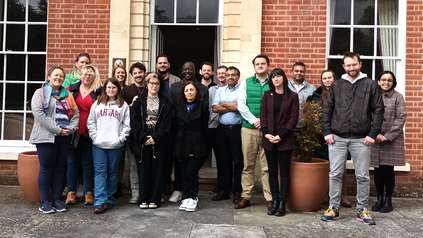Mystery of treatment-resistant childhood leukaemia uncovered
A team at the Wellcome Sanger Institute, Great Ormond Street Hospital, Addenbrooke’s Hospital, University College London, and their collaborators mapped the origins of T-cell leukaemia. They identified a new subtype of cancerous T-cells that does not respond to current treatments and could be responsible for the high mortality in this type of childhood cancer.
The research, published today (12 November) in Nature Communications, pinpointed the gene that is switched on in these cells, and how to identify them. These cells could be identified by adapting tests that are already used routinely by clinicians and could therefore be easily integrated into clinical care.
Being able to identify children whose cancer will not respond to treatment could directly impact their clinical care. For example, allowing them to avoid chemotherapies that have been proven to be ineffective against resistant cancers and prioritise other treatments.
Acute lymphoblastic leukaemia (ALL) affects the blood and bone marrow and is the most common type of childhood cancer, with 400 children diagnosed in the UK each year1. There are two different groups depending on which immune cells are affected: B-cell leukaemia (B-ALL) and T-cell leukaemia (T-ALL).
In general, outcomes for B-ALL have improved over the past few decades due to the development of new immunotherapies and the identification of genomic subgroups that can help tailor treatment2.
However, T-ALL makes up around 15 per cent of total cases and is a more aggressive disease. It has higher rates of treatment failure and drug resistance3, which occur in about 10 per cent of children with T-ALL4.
There is currently no way to identify which T-ALL cancers are more likely to be aggressive or high risk at diagnosis, meaning that clinical care cannot be adapted at the outset. Instead, children go through four weeks of the same chemotherapy and then undergo further tests to see if there are cancer cells remaining in the bone marrow. Being able to predict whether chemotherapy will work is of utmost importance to understand which children need less, and which children need more and different treatment from the outset.
In new research, the team at the Sanger Institute and their collaborators, analysed bone marrow samples from 58 children with T-ALL. They conducted single-cell genomic analysis to map the origins of all T-cells and identified genes that were more active in cancer cells that did not respond to the initial treatment.
The team found a new cancer cell type in children whose cancer did not respond to initial treatment.
In these treatment-resistant T-ALL cancer cells the gene, ZBTB16, is switched on. Once switched on, this gene causes the T-cells to develop into the new type of T-ALL cancer cell that carries the ZBTB16 protein. By analysing genomic data from hundreds of patients with ALL, they found that this genetic switch can happen at any point during T-cell development.
If included in clinical tests, this protein can be used as a marker to identify these cells from the day of diagnosis. It would involve adding an additional panel on a flow cytometry test, which is currently used during cancer care. The team suggests that this could be used to enable clinicians to closely monitor and adapt the treatment of children with T-ALL when possible.
The discovery also suggests a new avenue for future drug development, as treatments that switch off this gene could potentially stop cancer cell growth. Immunotherapy that targets this specific T-ALL cancer cell could also be possible in the future, giving new, effective therapies with fewer side effects for those living with this condition.
“Until now, it has not been possible to tailor treatment for T-cell acute lymphoblastic leukaemia in the same way as we can for B-cell leukaemia. Being able to identify children who have T-cell leukaemia that will not respond to initial treatment on the day of their diagnosis is of great importance. While further clinical research is needed, the genetic marker we have discovered can also be identified using an already widely used test, meaning that it could be easily adopted into clinical care if proven effective.”
Dr David O’Connor, co-senior author at UCL and Consultant in Paediatric Haematology at Great Ormond Street Hospital
“The discovery of this new type of cancerous T-cell is one of the most exciting findings of my career so far, and warrants urgent investigation so that it can be translated into clinical impact as soon as possible. Using genomics to understand the origins of cancer allows us to find new ways to identify it and opens up avenues for being able to treat it. For example, targeting these newly discovered cancer cells could lead to effective therapies for T-cell leukaemia that currently don’t respond to first-line treatment, something that children, and adults, living with this cancer urgently need.”
Professor Sam Behjati, co-senior author at the Wellcome Sanger Institute and Honorary Consultant Paediatric Oncologist at Addenbrooke’s Hospital
Jacob’s story
Three-year-old Jacob was diagnosed with T-ALL leukaemia in December last year after his parents took him to their local A&E after noticing he had dark-coloured bruises on his arm, a rash on his face and was vomiting. A blood test showed his white blood cell count was extremely high (850 compared to a normal range of 5-15) and he was immediately transferred to Great Ormond Street Hospital for treatment.
“Since Jacob was diagnosed with leukaemia last December, it’s been a complete whirlwind of a journey. Luckily, he responded amazingly well to the first blocks of chemotherapy despite having a very aggressive form of leukaemia, which meant he could continue the standard treatment and did not need to have a bone marrow transplant.
All of the staff, from the doctors and nurses to porters and play specialists, have been fantastic during our time in hospital.”
Jacob’s parents, Alexandria and Animesh, from Chelmsford in Essex
Jacob is now in remission and continuing along the standard T-ALL leukaemia chemotherapy protocol, which lasts for just over a total of two years.
“Research like this is so important to help move towards a future where children can have the right cancer treatment more quickly. While we were fortunate that Jacob responded really well to his chemotherapy, we spent a number of months waiting for his bone marrow test results to come back to confirm that he could continue on a chemotherapy-only protocol rather than having to try another treatment, as the tests have to be done at specific timepoints.
If we had known from the beginning that this would likely be the case it would have provided us with some reassurance in what was a difficult time, and we truly hope that these new developments will help other parents who find themselves in the same position.”
Alexandria and Animesh, Jacob’s parents
More information
The researchers are incredibly grateful to the children and their families who participated in this research.
- Cancer Research UK. What is childhood acute lymphoblastic leukaemia (ALL)? Available at: https://www.cancerresearchuk.org/about-cancer/childrens-cancer/acute-lymphoblastic-leukaemia/about [Accessed July 2025]
- Jen, E. Jabbour, H. M. Kantarjian, N. J. Short. (2024) ‘SOHO State of the Art Updates and Next Questions | Novel Agents and the Diminishing Role of Allogeneic Stem Cell Transplant in B-Acute Lymphoblastic Leukemia’. Clinical Lymphoma Myeloma and Leukemia. DOI: 10.1016/j.clml.2024.02.017.
- M. Goldberg, et al. (2003) Childhood T-Cell Acute Lymphoblastic Leukemia: The Dana-Farber Cancer Institute Acute Lymphoblastic Leukemia Consortium Experience. Journal of Clinical Oncology DOI: 10.1200/JCO.2003.10.116
- A. Raetz, et al. (2023) Outcome for Children and Young Adults With T-Cell ALL and Induction Failure in Contemporary Trials. Journal of Clinical Oncology. DOI:10.1200/JCO.23.00088
Publication:
B.S.J. Lim, H. J. Whitfield, M. K. Trinh, et al. (2025) ‘A non-canonical lymphoblast in refractory childhood T-cell leukaemia’. Nature Communications. DOI: 10.1038/s41467-025-65049-8
Funding:
This research includes funding from Wellcome, Cancer Research UK, the Harley Staples Cancer Trust, the Agency for Science, Technology and Research, the Wenner-Gren Foundation, the Pessoa de Araujo family, The Little Princess Trust, the EMBO long-term fellowship, and the National Institute for Health and Care Research. A full acknowledgement list can be found on the publication.





